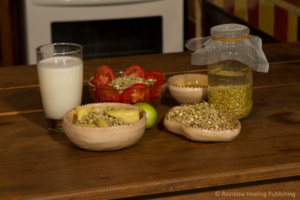
SPROUTING YOUR OWN SEEDS – WHY & HOW
Heading into the fall and winter seasons it is good to know that, even in the north, we can still grow some of our own food, packed with vitality and nutrients, helping to fend off those pesky colds and flus that are certain to make their come back.
PART 1 – WHY SPROUT YOUR OWN SEEDS
Today’s post covers WHY to sprout. In the following posts I will provide specific instructions plus additional information.
Why Sprout?
Sprouting is a great way of adding high quality nutrition to your daily life. Sprouts are the only food source that is still alive when we eat it. The process is easy and can be done by anyone with supplies found in every home kitchen. No extra space is required, even the smallest kitchen will do. Sprouting is very economical and therefore is suitable for any budget.
Any seeds and nuts can be used for sprouting; however, it is best to use certified organic seeds and only those that are intended as food crop rather than farm planting seeds. This minimizes the risk of contamination.
To my knowledge, organic sprouting seeds have not been implicated in any outbreak of food poisoning.
Sprouts contain the highest concentration of phytonutrients per calorie of any food. Phytonutrients provide a great spectrum of health benefits.
Benefits of Eating Sprouts
➣ Great source of nutrition; sprouts are rich in vitamins, minerals, proteins and enzymes
➣ Support and nourishment for the entire body including immune system and cardio vascular health
➣ Very easily digested and assimilated
➣ Improvement of the efficiency of the digestive system
➣ Protection against free radical damage
➣ Very inexpensive
➣ Available year-round even when other vegetables and fruits are not available
➣ Easy to grow at home
➣ Great variety of usages
➣ Plus lots more
Commonly Used Seeds for Sprouting
Alfalfa – Beans (various) – Broccoli – Chia – Chickpeas – Fenugreek – Lentils – Mustard – Peas – Pumpkin – Radish – Red Clover – Sunflower
NOTE: Most seeds and nuts can be used for sprouting but some may require more equipment and experience than the ones mentioned above.
Avoid sprouting seeds from plants that have poisonous parts.
You can save some of your garden seeds and use them for sprouting i.e. radish, caragana seeds

SPROUTING PART 2 – HOW TO SPROUT YOUR OWN SEEDS
For an actual demonstration on how to sprout check out my DVD, “Herbal Pharmacy for Everyone” visit http://herbalinstructions.com/
 EQUIPMENT REQUIRED
EQUIPMENT REQUIRED
➣ A glass jar, any size from about 1 litre to 4 litres will do; wide mouth jars are the most practical
➣ Nylon mosquito screen, big enough to cover the opening of the jar and rubber band to secure it
➣ Fresh water
➣ Seeds for sprouting
a. I suggest you begin, using only one type of seed per jar. Once you have gained some experience, have fun experimenting, creating your own special mixes.
b. How many seeds to use? As the seeds absorb the water and begin to sprout, they will expand; different seeds will expand to different degrees. For example, radish seeds will expand more than sunflower seeds.
As a rule, fill the jar up to 1-2 cm with dried seeds. Using too few or too many, does not matter. You will learn quickly the proper amounts for the different types of seed you use.
INSTRUCTIONS
1. CLEANING
A. Place seeds in (wide mouth) glass jar; when using larger seeds like peas use more seeds
B. Cover jar with mesh and secure with rubber band
C. Rinse by adding water, swirl and drain
2. SOAKING
A. Add cool water, 5 – 10 cm above seeds and let sit 4 – 8 hours or over-night;
NOTE: The length of time for soaking the seeds depends on the type of seed used; check internet for soaking charts or refer to my next post.
B. Drain water, rinse and drain water again. Seeds should be damp but not “swimming” in water.
3. GROWING
A. Invert and prop jar at an angle in a bowl so that excess water can drain; preferably keep in dark place.
B. Twice a day rinse seeds with cool/room temperature water, swirl jar gently, drain and repeat step 3A.
C. Depending on the seeds, it will take 2 – 5 days for the seeds to sprout to a length of ½ – 5 cm when they are ready to be enjoyed.
4. EATING & STORING
Eat sprouts right away or store them in the fridge in a glass container or plastic bag. Treat them like you would any other food that can spoil.
Meal Suggestions
Sprouts can be added to salads, sandwiches, tacos, wraps, soups (just before serving), spaghetti sauce, omelets, green drinks and baking (1/2 cup of sprouts per loaf; add to liquid ingredients). Sprouted seeds may also be sautéed, blanched or steamed.
Sprouting beans will soften them enough, making them suitable for creating spreads such as hummus.
BE CREATIVE and most of all ENJOY!
To order the DVD “Herbal Pharmacy for Everyone – A Step-by-Step Guide to Creating You Own Herbal Preparations”, visit http://herbalinstructions.com/order-dvd/
SPROUTING YOUR OWN SEEDS – WHY & HOW
Heading into the fall and winter seasons it is good to know that, even in the north, we can still grow some of our own food, packed with vitality and nutrients, helping to fend off those pesky colds and flus that are certain to make their come back.
PART 1 – WHY TO SPROUT YOUR OWN SEEDS
Today’s post covers WHY to sprout. In the following posts I will provide specific instructions plus additional information.
Why Sprout?
Sprouting is a great way of adding high quality nutrition to your daily life. Sprouts are the only food source that is still alive when we eat it. The process is easy and can be done by anyone with supplies found in every home kitchen. No extra space is required, even the smallest kitchen will do. Sprouting is very economical and therefore is suitable for any budget.
Any seeds and nuts can be used for sprouting; however, it is best to use certified organic seeds and only those that are intended as food crop rather than farm planting seeds. This minimizes the risk of contamination.
To my knowledge, organic sprouting seeds have not been implicated in any outbreak of food poisoning.
Sprouts contain the highest concentration of phytonutrients per calorie of any food. Phytonutrients provide a great spectrum of health benefits.
Benefits of Eating Sprouts
➣ Great source of nutrition; sprouts are rich in vitamins, minerals, proteins and enzymes
➣ Support and nourishment for the entire body including immune system and cardio vascular health
➣ Very easily digested and assimilated
➣ Improvement of the efficiency of the digestive system
➣ Protection against free radical damage
➣ Very inexpensive
➣ Available year-round even when other vegetables and fruits are not available
➣ Easy to grow at home
➣ Great variety of usages
➣ Plus lots more
Commonly Used Seeds for Sprouting
Alfalfa – Beans (various) – Broccoli – Chia – Chickpeas – Fenugreek – Lentils – Mustard – Peas – Pumpkin – Radish – Red Clover – Sunflower
NOTE: Most seeds and nuts can be used for sprouting but some may require more equipment and experience than the ones mentioned above
Avoid sprouting seeds from plants that have poisonous parts.
You can save some of your garden seeds and use them for sprouting i.e. radish, caragana seeds
STAY TUNED for next week’s post on HOW to sprout.




Follow Us!